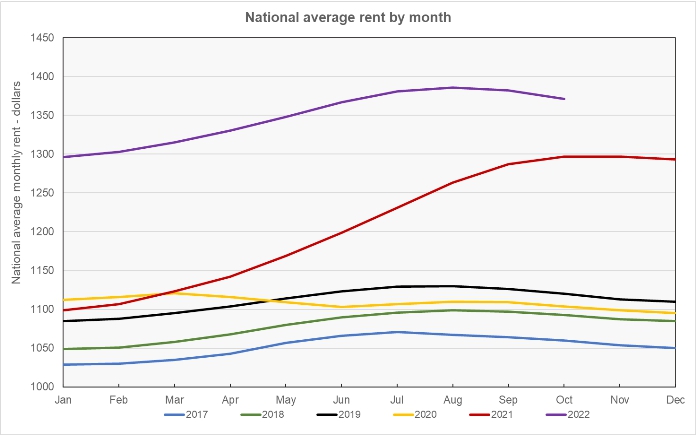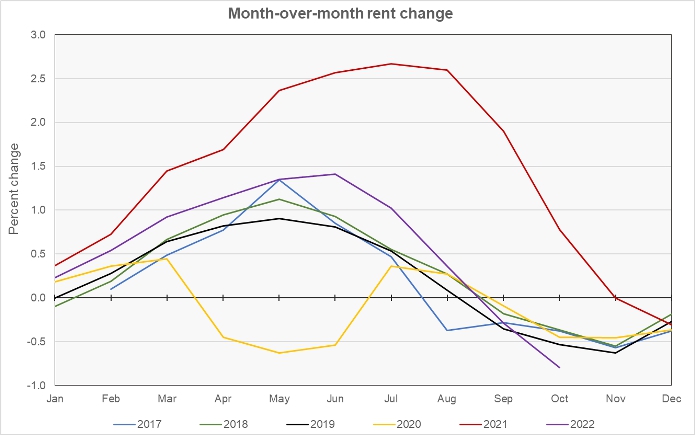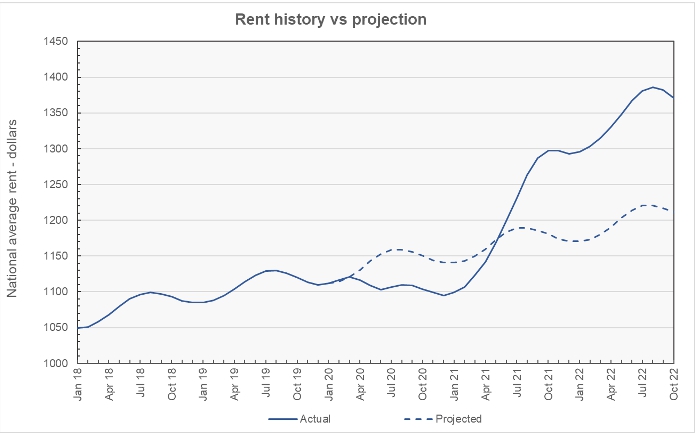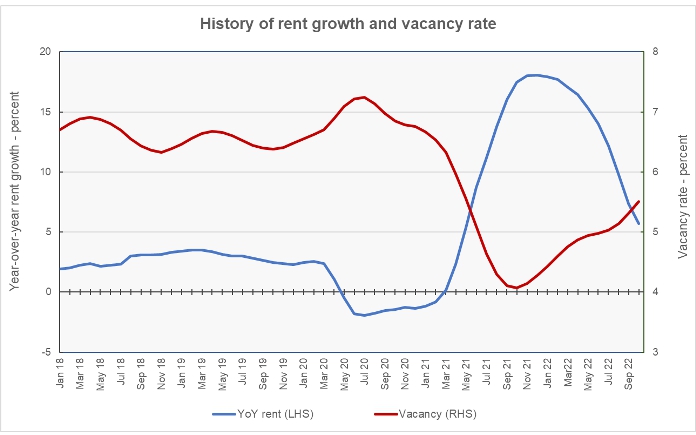The latest rent report from Apartment List shows that the national average rent growth in October remained negative for the second consecutive month. Rents fell 0.8 percent month-over-month, although year-over-year rent growth remained positive, with a 5.7 percent rise.
The pattern of rent growth
The first chart shows the history of the national average rent level since 2017. It is plotted year-by-year so that the annual change pattern is visible. The chart also shows the national average rent in 2022 through October. The chart shows the regular rise in rents in the years leading up to the pandemic and how different the pattern of rent growth has been since the pandemic’s start, with rents falling in 2020 but then rising at extraordinary rates in 2021.

The next chart shows the month-over-month rent growth for each year in the Apartment List data set. The chart shows that month-over-month rent growth in 2022 has been closer to the pattern of the pre-pandemic years than it has to the pattern of the first two years after the pandemic arrived. While the month-over-month rate of rent growth in 2022 had been running ahead of rates for the same months in the pre-pandemic years, it fell below those rates in October.

The history of rent changes for the last 4+ years is shown in the next chart, below, along with a projection of where rents would be if the pattern of growth that existed before the pandemic had continued*. By this estimate, rents are now about $159 per month (13 percent) above where they would have been if they had followed the prior trend.

The final chart shows the year-over-year rate of rent growth since January 2018 plotted along with the national average apartment vacancy rate. It shows rents fell as the vacancy rate rose after March 2020, but rents then surged as the vacancy rate plunged in early 2021. In 2022, both the year-over-year rate of rent growth and the vacancy rate have been slowly moving toward their pre-pandemic levels.

Leaders and trailers
Apartment List provides the underlying data they collected in compiling their report and that data was used to create the tables, below. The tables look at the 52 metropolitan statistical areas defined by the US Census Bureau with populations over 1 million and identify the top and bottom 10 metros for year-over-year rent growth. The tables provide the average monthly rent in the metro, the metro’s vacancy rate, the annual percentage change in rent (YoY Metro) along with the percentage change from the prior month’s rent level (MoM Metro). They also list the percentage change in rent for the metro area compared to the rent level in February 2020, right before the pandemic struck (Feb 20).
The first table shows the 10 metros with the largest annual rent growth by percentage. Only one of the top ten metros for year-over-year rent growth, St. Louis, saw its rents rise from September to October. In fact, St. Louis was the only one of the 52 largest metros that saw rents rise month-over-month in October. It is also noteworthy that San Jose, one of the last metros to recover from the rent drops it experienced early in the pandemic, is now on the top ten list for fastest year-over-year rent growth.
| Metro | Metro Rent | Vacancy | YoY Metro | MoM Metro | Feb 20 |
| New York | $2,070 | 3.9 | 9.9 | (1.57) | 18.6 |
| San Diego | $2,405 | 3.9 | 9.3 | (0.87) | 33.5 |
| New Orleans | $1,241 | 5.8 | 9.0 | (0.24) | 21.9 |
| Louisville | $1,064 | 6.1 | 8.9 | (0.56) | 18.4 |
| Dallas | $1,490 | 6.3 | 8.7 | (0.80) | 26.5 |
| St. Louis | $1,145 | 4.8 | 8.3 | 0.35 | 19.8 |
| San Jose | $2,542 | 4.9 | 8.3 | (2.00) | 3.9 |
| Miami | $2,050 | 5.2 | 8.2 | (0.49) | 35.9 |
| Orlando | $1,670 | 5.2 | 8.2 | (1.12) | 32.6 |
| Kansas City | $1,205 | 5.2 | 8.0 | (0.66) | 20.5 |
The next table shows the 10 metros with the smallest annual rent increases. Interestingly, several of the metros on this list, like Las Vegas, Phoenix, Jacksonville and Riverside, are among the leaders in rent growth since the start of the pandemic. However, vacancies have risen by over two percentage points in each of these metros over the past 12 months, putting pressure on rents.
| Metro | Metro Rent | Vacancy | YoY Metro | MoM Metro | Feb 20 |
| Las Vegas | $1,546 | 6.2 | (1.0) | (1.02) | 32.9 |
| Phoenix | $1,616 | 6.2 | (0.1) | (1.16) | 32.6 |
| Sacramento | $1,753 | 4.4 | 0.2 | (0.68) | 24.5 |
| Jacksonville, FL | $1,528 | 6.2 | 1.7 | (1.04) | 34.7 |
| Riverside | $1,948 | 4.2 | 1.8 | (1.27) | 34.6 |
| Baltimore | $1,639 | 4.5 | 1.8 | (0.79) | 19.6 |
| Detroit | $1,162 | 4.6 | 2.0 | (1.02) | 19.7 |
| Virginia Beach | $1,603 | 4.1 | 2.1 | (0.56) | 26.0 |
| Atlanta | $1,575 | 5.6 | 2.3 | (0.82) | 29.3 |
| Minneapolis | $1,226 | 6.9 | 2.6 | (0.41) | 5.0 |
The complete Apartment List report covers many more metros. It also provides readers with the opportunity to download their data sets. It can be found here.
*The idea for this chart came from the folks at Apartment List.













